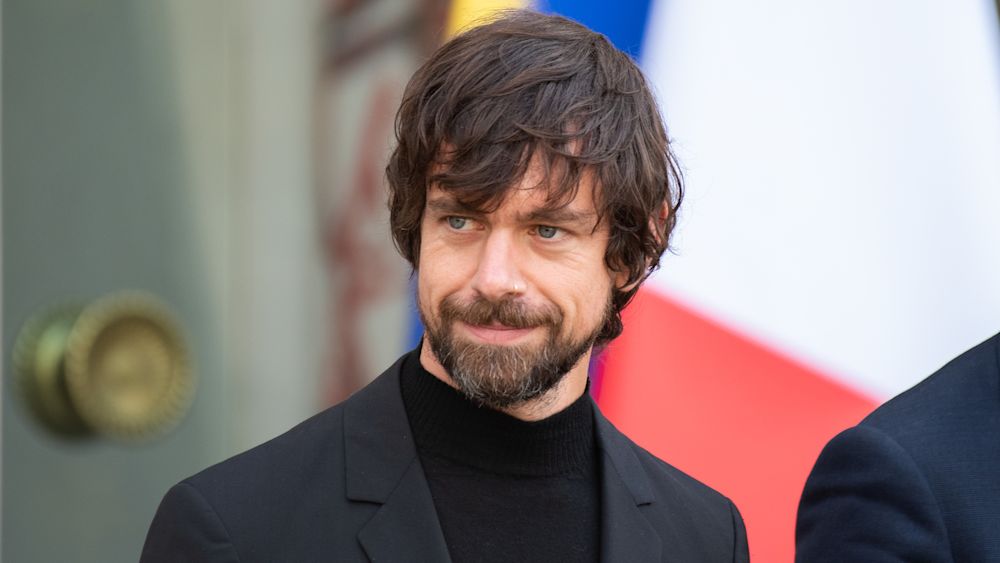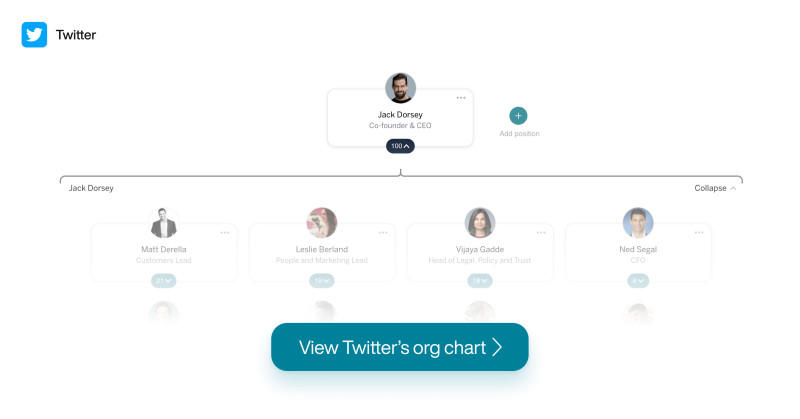- Iterate
- Meet The Team
- The Most Influential People behind the Scenes at Twitter
The Most Influential People behind the Scenes at Twitter
The Org has identified the most influential people behind the scenes at Twitter, one of the world’s foremost social media platforms. Here’s our exclusive org chart of the top executives and their roles.

Not all CEOs are household names, but a recent public spat with the White House has ensured CEO of Twitter, Jack Dorsey, is. Dorsey founded the microblogging platform in 2006 with colleagues from podcasting start-up Odeo, Evan Williams, Noah Glass and Biz Stone.
The Org has identified the most influential people behind the scenes at Twitter, one of the world’s foremost social media platforms. Here’s our exclusive org chart of the top executives and their roles.
Dorsey came up with the idea that would become Twitter while studying at NYU (the future billionaire dropped out before graduating). It wasn’t his first enterprise -- Dorsey, who taught himself to code, developed dispatch programming as a teen that is still used by some taxi companies. But when he discovered SMS through a colleague at Odeo he was blown away, and quickly got to work developing his idea for the short-form messaging platform.
“I thought, what if we simply set status, archive it on the Web, use SMS to do it, and it all happens in real time?,” Dorsey said in Mastering The VC Game by Jeffrey Bussgang.
Odeo developed what was then called Twttr, launching the platform that allows users to send 280 character ‘tweets’ in July 2006, with Dorsey as CEO. He was removed from that position in 2008, became chairman of the board, then returned as CEO in 2015. In the meantime, Dorsey founded mobile payment company Square.
In 2013, Twitter went public and Dorsey became a billionaire within hours. Although he reportedly earned only $1.40 as Twitter CEO in 2019, he holds shares in the company worth more than $550 million. Dorsey is the only co-founder still involved in running the company, which is now valued at more than $27 billion.
Since its launch, Twitter has been seen as a platform for public conversation, connection and debate, but it hasn’t been without its controversies. A central question has been over the level of responsibility it holds for what users publish. Dorsey has been in the news recently for allowing for fact-check labels to be added to the President of the United States’ tweets during a time when hundreds of thousands of Americans are protesting police brutality and racial injustice. In response, the President has threatened increased regulation on social media.
In a 2019 TED talk, Dorsey acknowledged that Twitter had been responsible for the spread of abuse and misinformation, saying the team hadn’t foreseen these challenges 13 years ago. Silicon Valley has long avoided taking responsibility for user content, but since the 2016 election, rife with foreign interference and campaigns of misinformation, tech companies are reckoning with moral obligations.
The leadership team at Twitter decided last year to ban political ads, with customer lead Matt Derella saying the company was trying to make sure it didn’t create further information silos on the platform. Derella came to Twitter from Google, and leads the company’s customer-facing operations, as one member of Twitter’s ten person executive leadership team.
People and marketing lead Leslie Berland became Twitter’s first-ever chief marketing officer in 2016, and is not only responsible for global consumer, product, and sales marketing and communications, but is also charged with maintaining a healthy work culture at the company. Berland, who previously worked at American Express, told CNBC she likes to hold meetings outside, often while walking.
In 2018, the company decided to split its job for product and engineering into two roles, after years of high turnover rates in the position Vanity Fair once called “cursed”. Kayvon Beykpour, who cofounded live video platform Periscope, acquired by Twitter in 2015, took over as product lead, responsible for product strategy and development. Mike Montano, who cofounded SaaS social media analytics service BackType and has been with Twitter since 2011, was named engineering lead.
Other members of the executive leadership team include legal, public policy, and trust and safety lead Vijaya Gadde, chief financial officer Ned Segal, technology lead Parag Agrawal, revenue product lead Bruce Falck and design and research lead Dantley Davis.
Earlier this year, activist hedge fund Elliot Management, which has a sizeable stake in Twitter, attempted to oust Dorsey as CEO and instate four new board members. It got the four board seats, but came to an agreement with Dorsey who stayed on as CEO.
Last week, Twitter announced former Google CFO Patrick Pichette would become chairman of the Board of Directors. Pichette replaces Omid Kordestani who will remain on the Board as a non-employee director. Pichette is expected to more intensely scrutinize the company’s management and bring a stronger focus on financial matters, according to Reuters.
Amid leadership changes, political spats, and a world dealing with mass protest and the coronavirus pandemic, Twitter has remained a central tool for many to spread and receive information. And through the upheaval its staff have donated largely to philanthropic efforts, including Dorsey who said he would donate $1 billion, 28 percent of his total wealth, to coronavirus relief efforts, and recently Dorsey donated $3 million to Colin Kaepernick’s legal defense organization.
It’s not just those behind the scenes using Twitter for philanthropic means; in the last two weeks users have made “match donations” trend so much on Twitter the Minnesota Freedom Fund went viral and gained tens of millions of dollars in donations.
Since it’s conception Twitter has played a part in political uprisings and protests across the globe, it has raised funds for countless causes, spurred conversation and engagement, and for better or worse, become a domain for elected leaders to govern (plus many other things). As we stand in 2020, the company has become such a part of public discourse, it would be hard to imagine the world without it.
--
Sign up now: Stay up to date, level up and hire better with our behind the scenes newsletters at the world’s top startups.


The ORG helps
you hire great
candidates
Free to use – try today
